CUCAMONGA YEARS: SINGLES AND BROADCAST MUSIC
Next to movie scores, singles, radio and TV appearances were giving Zappa opportunities to make himself and his music known to the public. It would last till 1966 before he had a regular record company contract, by many seen as the start of his career as a pop star. But when you're adding everything up from all available sources, a lot had already happened before 1966, sufficient to spend five sections of this study on the period 1958-1965.
BROADCAST MUSIC 1962-1963Steve Allen show - Mount St. Mary's concert - Opus 5
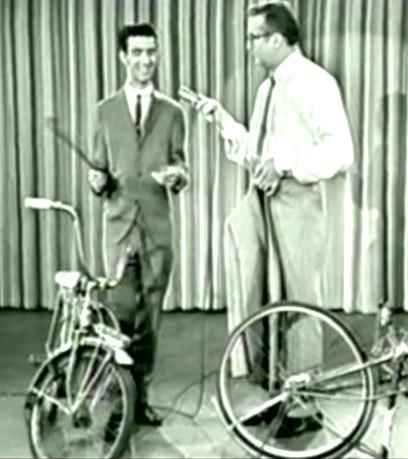 Zappa applied several times in vain for a guest appearance with his band on the Steve Allen show, a then popular TV
talkshow. When he suggested an absurdity for playing "Bicycle for two" he did get in. The tape
has been kept completely in the Channel 5 archives (still to the left, 1962). Zappa's appearance lasted 13 minutes,
doing some funny entertainment with Steve Allen cooperating. The music was a collage of Zappa and Allen extracting
sounds from the bikes with their hands, bows and drumsticks. Along with it came a pre-recorded tape with among others
Zappa's first wife playing a clarinet, electronically mutated. The orchestra could improvise and were asked to
"refrain from musical tones" by Zappa.
Zappa applied several times in vain for a guest appearance with his band on the Steve Allen show, a then popular TV
talkshow. When he suggested an absurdity for playing "Bicycle for two" he did get in. The tape
has been kept completely in the Channel 5 archives (still to the left, 1962). Zappa's appearance lasted 13 minutes,
doing some funny entertainment with Steve Allen cooperating. The music was a collage of Zappa and Allen extracting
sounds from the bikes with their hands, bows and drumsticks. Along with it came a pre-recorded tape with among others
Zappa's first wife playing a clarinet, electronically mutated. The orchestra could improvise and were asked to
"refrain from musical tones" by Zappa.
Experimental collage music was also on the program for the Mount St. Mary concert from 1963. This time it was serious.
Zappa spend quite some time explaining to the audience what the set-up of the different pieces was. A necessary
move, that helped to make the audience receptive to the ideas presented. The centre piece was "Opus 5". Zappa had written out
separate music for the piano and three different groups from the Pamona Symphony Orchestra, the music
divided over several smaller theme blocks. First
the three and a half minutes piano part was played separately. It's entirely atonal, playing with
motifs, intervals and tempi. Presented below
is a section taken from it. The piece has the character of a written out improvisation. It's through-composed without
central themes. Bars 1 and 2 are variations upon each other. Bar 3 is transitory. Bars 4-11 form a sequence in 4/8. Bars
12-16 are a sequence in 3/8.
Opus 5, piano part, section (midi file).
Opus 5, piano part, section (transcription).
The other groups had similar sheet music. The conductor of each group could indicate what block to play at will, pause or
ask his group to improvise. Thus the piece is highly flexible. It would sound different each time played. Anew
a pre-recorded tape with modified sounds was included as part of "Opus 5". Zappa
presented a section of the tape played solo as well. After the short intermission of the one hour concert "Opus 5" was played in full. The "Mount St. Mary's
concert excerpt" on "The lost episodes" is made up of sections from its execution. Without Zappa's introduction it sounds as
a nice but rather haphazard collage of sounds. With it the idea of the experiment becomes understandable.
Mount St. Mary's concert excerpt, 0:40-0:49 (midi file).
Mount St. Mary's concert excerpt, 0:40-0:49 (transcription).
It's not fit for transcribing, so I've limited myself to a fragment of nine seconds. In bars 1-2 of this example the brass and wind sections are playing a sustained
A and three little melodies. The rhythm of these three melodies is irregular and probably improvised. Bars 3-4 contain the formation of a piano chord.
The concert got broadcast by the L.A. radio station KPFK, only partially in 1963 en in full in 1974. In the Zappa biography by Roman Garcia Albertos you can read
how it came into being by their employee Carlos Hagen having recorded it, on page 79 noting that "At the time he could only broadcast some fragments, but in the seventies, when Zappa
was known worldwide, he produced a special program for the station with a good deal of the recordings. Zappa obtained a copy of the tape and included a short fragment of
"Opus 5" in his album "The lost episodes" (1996)." This book is for its notes and references referring to the corresponding Information is not knowledge site, where
you can find a full text of the 1974 radio broadcast with Carlos Hagen doing an introduction. In the Greg Russo book you can find a copy of the 1963 concert program.
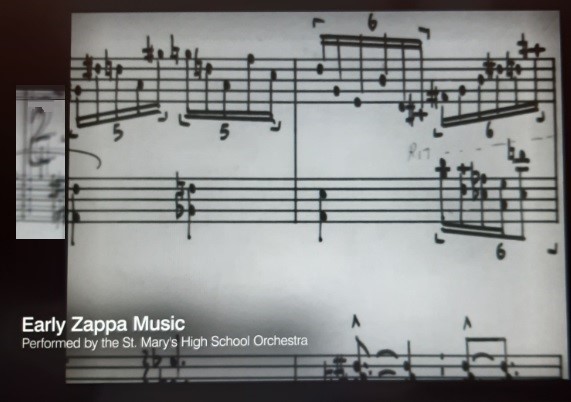
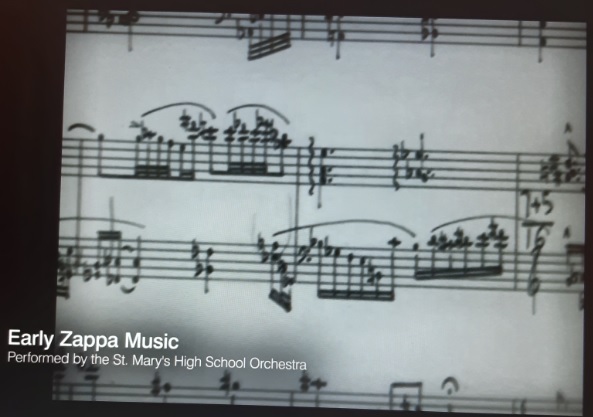
Piano music for the Mount St. Mary's concert, left image (midi file).
Piano music for the Mount St. Mary's concert, right image (midi file).
Piano music for the Mount St. Mary's concert, as shown during the Zappa documentary from 2020 by Alex Winter.
The last two snippets are atonal music, very likely for piano, along the two images above. The first example contains two bars in 2/4, the second two bars in 6/8. These two fragments are too small
to get an idea of the composition they are part of. What you can see is the rhythmic variety, achieved by changing note durations, irregular rhythmic groupings
and changing meters. Next to 2/4 and 6/8, (7+5)/16 is visable as an odd meter.
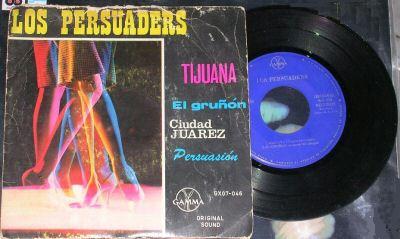 During his stay in Cucamonga Zappa cooperated with Paul Buff and others to
release various singles for the local market. They contain traditional rhythm and blues and doo-wop music with fantasy-like
group names as "Baby Ray and the Ferns". These singles are some of the few recordings
that the Zappa family trust doesn't have the copyrights of. During recent years these
tracks have appeared on small labels with titles as "Cucamongo Years" or "Rare Meat".
Listed below are the ones for which Zappa contributed
in songwriting. The artist on the B-side is the same as on the A-side, unless indicated. Three of them have had some success. "Memories of El Monte" got
a few times re-released or included in doo-wop collections. On the "Cucamonga years"
CD it's attributed to 1962, other sources state that it stems from 1963. Paul Buff's "Tijuana surf"
became a hit in Mexico with Zappa's "Grunion run" on the flip side (to the right an issue as EP, anonymous eBay posting).
"Love of my life" is the one that Zappa would record anew three times later on.
During his stay in Cucamonga Zappa cooperated with Paul Buff and others to
release various singles for the local market. They contain traditional rhythm and blues and doo-wop music with fantasy-like
group names as "Baby Ray and the Ferns". These singles are some of the few recordings
that the Zappa family trust doesn't have the copyrights of. During recent years these
tracks have appeared on small labels with titles as "Cucamongo Years" or "Rare Meat".
Listed below are the ones for which Zappa contributed
in songwriting. The artist on the B-side is the same as on the A-side, unless indicated. Three of them have had some success. "Memories of El Monte" got
a few times re-released or included in doo-wop collections. On the "Cucamonga years"
CD it's attributed to 1962, other sources state that it stems from 1963. Paul Buff's "Tijuana surf"
became a hit in Mexico with Zappa's "Grunion run" on the flip side (to the right an issue as EP, anonymous eBay posting).
"Love of my life" is the one that Zappa would record anew three times later on.
Breaktime
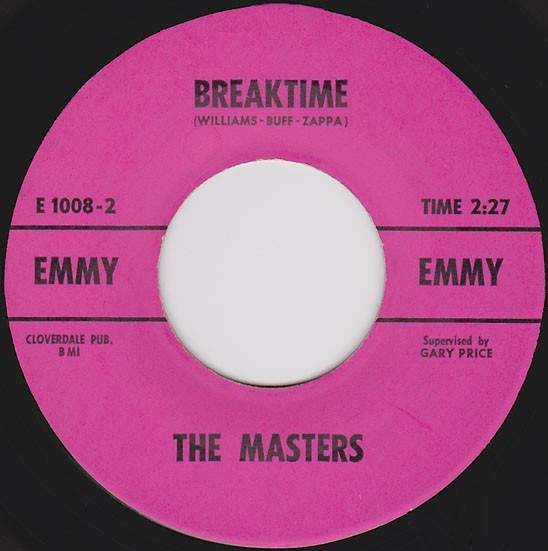 A Sixteen (M. Travis) by The Masters
A Sixteen (M. Travis) by The Masters
B Breaktime (R. Williams, P. Buff, Zappa)
Breaktime, section (midi file).
Breaktime, section (transcription).
The instrumental "Breaktime" is a joint improvisation by Ron Williams, Paul Buff and Zappa. If I'm not mistaken Ron
Williams is playing the first guitar in the transcription and Zappa the second. To the right an image from this single, that I could copy
from the zappafrenzy site.
The transcribed section contains traditional fifties rock over a walking bass line. It has no clear key note, but tends towards C Dorian for its last two bars at the end.
Both Williams and Zappa are playing on beat consistently and their style is the same. Williams even copies a lick by Zappa.
Zappa plays G-C-Bb-G-C-D, starting on beat 4 in bar 2. Williams repeats this as G-C-Bb-G-C-Eb, starting on beat 4 in bar 3.
"Breaktime" was recorded a couple of months after the "Greatest sinner" score, but released earlier. It thus has the credit
of being the first Zappa recording to reach the market.
Memories of El Monte
A (Zappa, R. Collins) by The Penguins
B (depending on release)
Memories of El Monte, opening (midi file).
Memories of El Monte, opening (transcription).
"Memories of El Monte" is a doo-wop song by Zappa and Ray Collins in 6/8. The harmony follows a traditional cadence in G: I-IV-V and next via C+E back to I. Staffs 2-3
represent the doo-wop harmony vocals. How the Mothers played this song live can be heard on the 2024 ZFT release "Whisky a go go, 1968". On that occasion the song
ends with citing from other doo-wop songs, that have a comparable set-up, seguing into "Oh, in the sky".
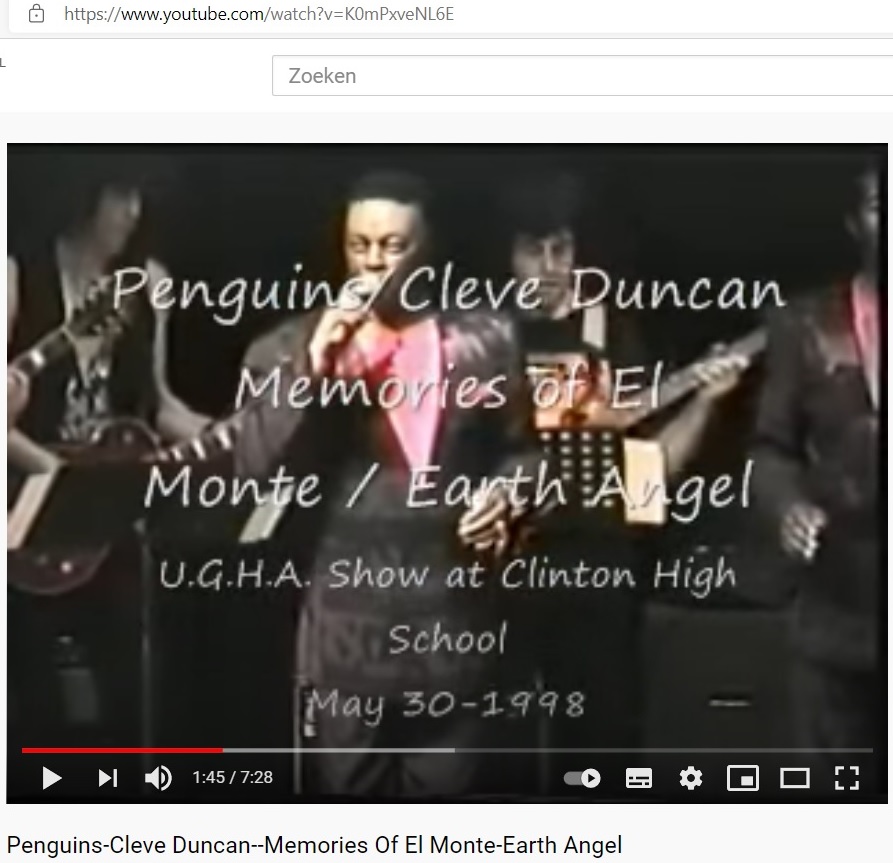
Cleve Duncan of The Penguins singing "Memories of El Monte" on Youtube. "Memories of El Monte" is today available in the Art Laboe series of earlier doo-wop songs.
It can also be heard in the Colors movie from 1988 featuring Robert Duvall and Sean Penn, though not included in the official soundtrack CD of this movie.
As it comes to its chord scheme, it's pretty much related to the earlier single of The Penguins, called "Earth angel", but this one has more to it.
Love of my life (1963)
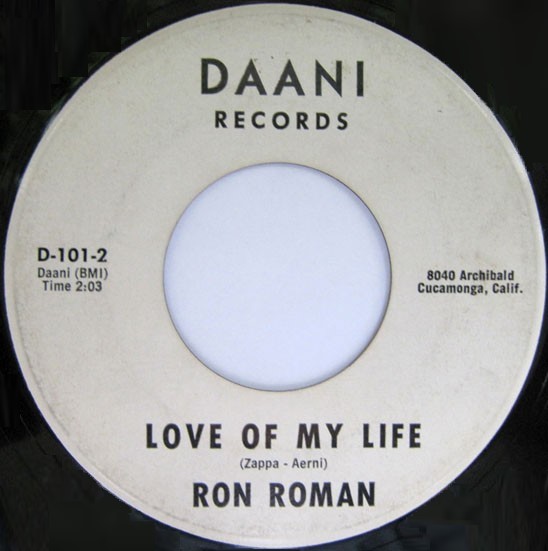 A Tell me (K. Williams) by Ron Roman
A Tell me (K. Williams) by Ron Roman
B Love of my life (Zappa, D. Aerni)
The single version of "Love of my life" used to be an obscurity, not included in any CD collection till it was
made downloadable by Paul Buff (see above). You can find images of the various singles in Greg Russo's Cosmic Debris book, as the one to the right I could copy from the zappafrenzy site.
There are three other versions of this song available in Zappa's CD collection. The first stems from "Cruising with Ruben and the Jets". On this album it's
a straightforward performance with a doo-wop voice in the bass all through. The chords are played as continuous
eight notes in a 12/8 meter, or - when you're notating in 4/4 - ongoing triplets. Ian Underwood thus gets credited
for playing these killer triplets. They are killing, not because there's any difficulty in them, but for their
repetitiveness. Zappa deliberately sought for simplicity on this album. The other two were recorded in 1980.
See the Tinsel town rebellion section of this study for the "Love of my life (1980)" versions.
Love of my life (single version), 0:44-1:15 (midi file).
Love of my life (single version), 0:44-1:15 (transcription).
The single version was brought out by David Aerni. It had a newly recorded vocal part in it with revised lyrics,
which is why you see his name between brackets on only this version.
As it comes to whether this was done with Zappa's approval, he wrote me in May 2011 assuring that
"I had the greatest respect for FZ and would have never done anything without
his approval. This was many years ago and I don't remember the
circumstances, but rest assured nothing was done without Frank's
approval."
Love of my life (original version), 1:08-1:29 (midi file).
Love of my life (original version), 1:08-1:29 (transcription).
The preceding first recording, that is included in the ZFT release "Greasy love songs",
has exactly the same lyrics as Zappa's later versions. Paul Buff mentions in his comment upon the single (http://www.cdbaby.com/cd/PaulBuffVariousArtists)
that the original recording was sung by Ray Collins, so that's indeed the "Greasy love songs" one featuring Ray Collins and Mary Gonzales.
"Love of my life" has two themes, with the construction being A-B-A. The sound quality of both recordings isn't bright enough to get at a good
transcription, but, as I'm hearing it, the musical tracks were kept the same for the single. So only the sung part got replaced.
In the examples from above you can hear:
Single version
- Bars 1-2: end of the first theme in G Mixolydian.
- Bars 3-8: most of the second theme.
Original version
- Bars 1-4: end of the second theme. The first two bars overlap with bars 7-8 from the single version example.
One can note that not only the lyrics are going differently, but also that the rhythm has been adapted.
- Bars 5-6: return of the first theme, now in G major with an F# in the harmonies.
How's your bird
A How's your bird (Zappa) by Baby Ray & the Ferns
B The world's greatest sinner (Zappa)
How's your bird, 0:56-1:19 (midi file).
How's your bird, 0:56-1:19 (transcription).
The example above from "How's your bird" is the instrumental section from the middle of this song with one complete cycle of the 12-bar blues scheme.
It's in C Dorian with chromatic notes being included as well. It starts right away with an E natural, so like mingling Dorian and Mixolydian,
quite common in Zappa's music, though here only happening in bar 1. The D from the Dorian scale is only present occasionally and the A isn't used at all,
so one might also choose to call this example minor pentatonic or hexatonic. There are at least three guitars playing, when I'm hearing it correctly,
but since this recording is in mono, it's not always possible to distinguish them.
"The world's greatest sinner"
as a single is included in the Movies scores section of this study.
Dear Jeepers - Letter from Jeepers
A Dear Jeepers (Zappa) by Bob Guy
B Letter from Jeepers (Zappa)
Dear Jeepers, 0:56-1:12 (midi file).
Dear Jeepers, 0:56-1:12 (transcription).
"Dear Jeepers" is an early example of a collage where creapy sounds are determining the atmosphere. I've indicated them in the transcription as "howling", "squeaking door"
and "breaking glass", but the midi file can't represent them. Instead, the background music comes out better in the midi file. It's standard blues in C Dorian.
The recording isn't bright enough to be certain about each note, so, to a degree, it's an approximation. The song is about a Mr. Jeepers, receiving
and reading a letter that he got from Count Dracula, thanking him for attending one of his parties.
Letter from Jeepers, 1:09-1:25 (midi file).
Letter from Jeepers, 1:09-1:25 (transcription).
On his turn, Jeepers is thanking Count Dracula with another letter, the B-side of the single. This tune is only nominally in D Dorian. The chord progression
in the example from above is Dm-A-Dm-Gm-Dm, thus with deviations from the Dorian scale. The chord on step V is major and the chord on step IV is minor.
During the example I can't hear the piano chord on step IV, but at other instances it can be heard as Gm.
The big surfer
A The big surfer (Zappa) by Brian Lord & The Midnighters
B Not another one! (D. Aerni, P. Buff)
The big surfer, 1:00-1:14 (midi file).
The big surfer, 1:00-1:14 (transcription).
The example above is an outtake of 14 seconds from "The big surfer". In Paul Buff's archive (see the previous section) the following
comment about this song can be found: "The common theme here is that when Buff and Zappa did not release a record themselves, they licensed the record
to whatever large record company was interested. The Vigah! label was created by Paul Buff to handle Buff/Zappa records
that they could not initially place with the biggies. Vigah! was how President John F. Kennedy pronounced the word "vigor",
and since the label's first release featured radio personality Brian Lord's JFK impression, it was a fitting start for the label.
Zappa's "The big surfer" was the A-side, and featured an ending reference to the Peace Corps. After Buff and Zappa proved
to Capitol Records that the record was hot (because they bought all the copies at local stores but didn't tell Capitol!),
Capitol released the disc but recalled it just after two weeks when civil rights activist Medgar Evers was killed."
Evers had worked for the Civil rights movement. In no way there's any direct connection, but because Kennedy, the Peace Corps and the Civil rights movement got interrelated,
Capitol considered any attempt to make fun of Kennedy at this point inappropiate. It's just bad luck for Zappa and Brian Lord appears to have given the single
radio attention nevertheless. The music on the single is elementary, subservient to the lyrics. It's blues-like, the scale being C Mixolydian because of bar 4 from the example, where the guitar from staff two
has started soloing. It has a major triad upon step V from bars two and three, common in blues.
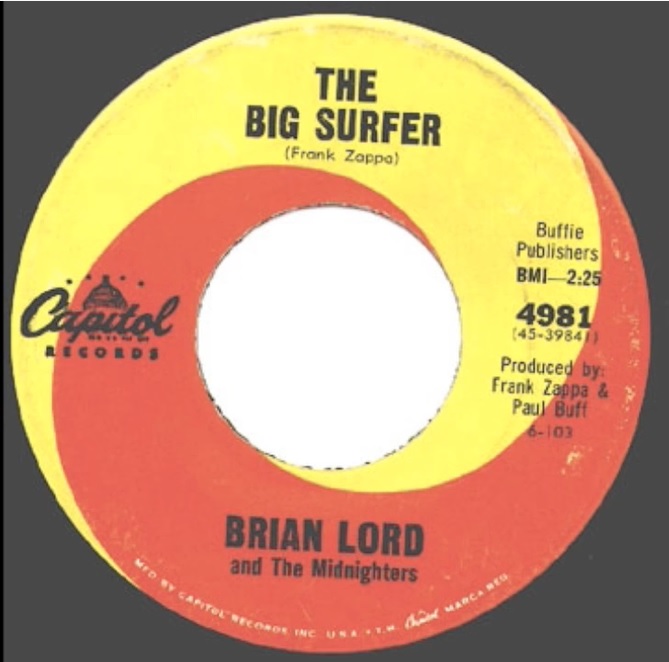
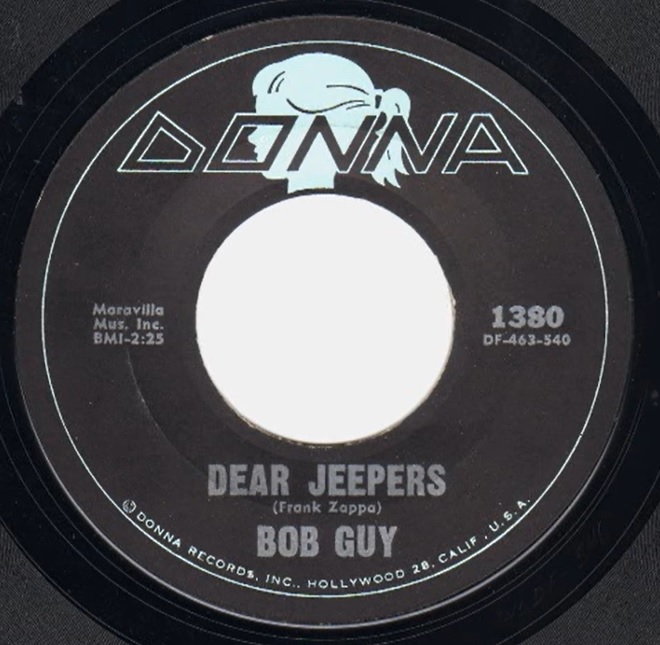
Labels from "The big surfer" and "Dear Jeepers".
Hey Nelda - Surf along
A Hey Nelda (Zappa, R. Collins) by Ned & Nelda
B Surf along (Zappa, R. Collins)
Hey Nelda, 0:53-1:05 (midi file).
Hey Nelda, 0:53-1:05 (transcription).
"Hey Nelda" is a parody of "Hey Paula" by Paul and Paula. The example from above is an outtake of 12 seconds from the middle of this single with Nelda and Ned discussing
their problems with agitated voices. Nelda gets impersonated by, I guess, Ray Collins singing with a high voice. It's definitely funny, especially
when you're listening to "Hey Nelda" after listening to "Hey Paula" first. Its comedy effect
gets a little lost by the lesser condition the vocal tracks of the tape are in, making it difficult to follow all the words of the text. Musically this section is in A, with the progression
D-E-A-F-D-E etc. When I'm hearing it correctly, altered notes are played over the first bass E instead of the standard triad upon E. Again, the tape makes it difficult to be positive
about such details.
Surf along, 0:49-1:06 (midi file).
Surf along, 0:49-1:06 (transcription).
The outtake from above from "Surf along" is the instrumental intermezzo plus the restart of the singing. It's blues in C Dorian with some liberty. During bars 2 and 4, with the I chord of the blues scheme, you can hear the E natural from the C Mixolydian scale too.
Bars 3 contains the V-IV progression from the scheme with the G chord being a major triad, common practice in blues. Bars 1-4 are instrumental with a guitar improvising.
In bars 5-6 the singer is back with a saxophone accompanying him (staff 3). Now this song is more brightly in C Dorian. Staff 4 is a percussion instrument with pitch.
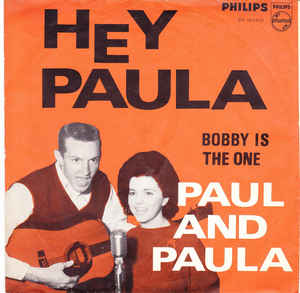
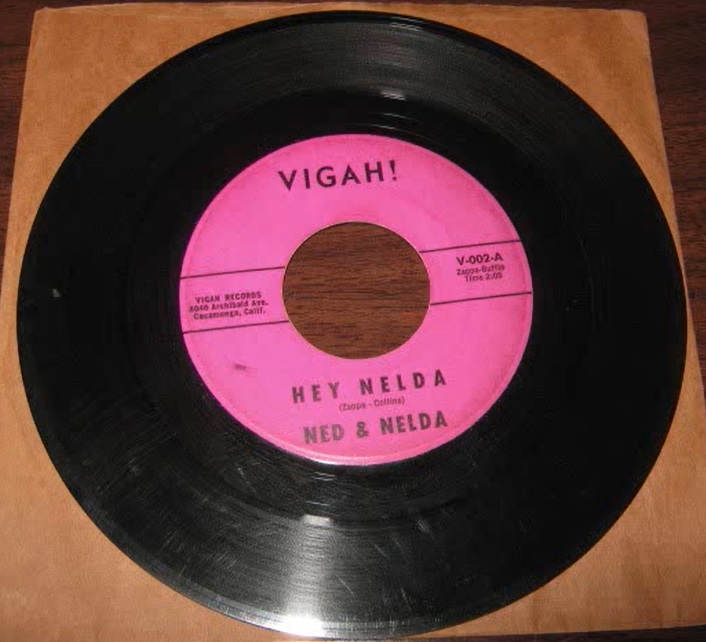
"Hey Paula" was a major hit from 1963 with Ray Hildebrand being "Paul", as well as the songwriter, and Jill Jackson representing "Paula". To the right the "Hey Nelda" single
as you can find it on YouTube. See the previous section for Paul Buff's archive, where you can obtain much of Zappa's earlier Cucamongo recordings as mp3 files.
Grunion run
A Tijuana surf (P. Buff) by The Hollywood Persuaders
B Grunion run (Zappa)
Grunion run, opening (midi file).
Grunion run, opening (transcription).
"Grunion run" is a blues instrumental in C Dorian.
The blues scheme in this case is: I (bars 1-4), IV (bars 5-6), I (bars 7-8), V (bar 9), IV (bar 10) and back to I again
in bar 11. Notable is the change of the rhythm in bars 9 and 10 via the accentuated notes, while the bass
keeps using the standard subdivision of a bar into 4.
Everytime I see you
A Everytime I see you (Zappa, R. Collins) by The Heartbreakers
B Cradle rock (W. Galleges)
Everytime I see you, section (midi file).
Everytime I see you, section (transcription).
Stylistically "Everytime I see you" belongs to the same category as "Memories of El Monte". And again it's co-written with Ray Collins.
It's friendly main stream pop music, sort of a crooner, following conventions both as it comes to chord progressions as to the lyrics.
These lyrics are exactly the love song lyrics that Zappa is opposing to in the Real Frank Zappa book. The song knows two themes, that get
repeated a few times, with an instrumental interlude betweem them. The example above is played between 0:13 and 0:38. Bars 1-2 are the tail
of theme one with G-D as progression in G. Below the G-chord the bass also plays an E and an A, so the overall harmony is getting wider at these points.
Bars 3-7 are theme two with a C-D progression, played three times during bars 3-5. Bars 6-7 are the closing bars of theme two, that, in fact, are a variation
upon material from theme 1. At this point with G-D7 as progression.
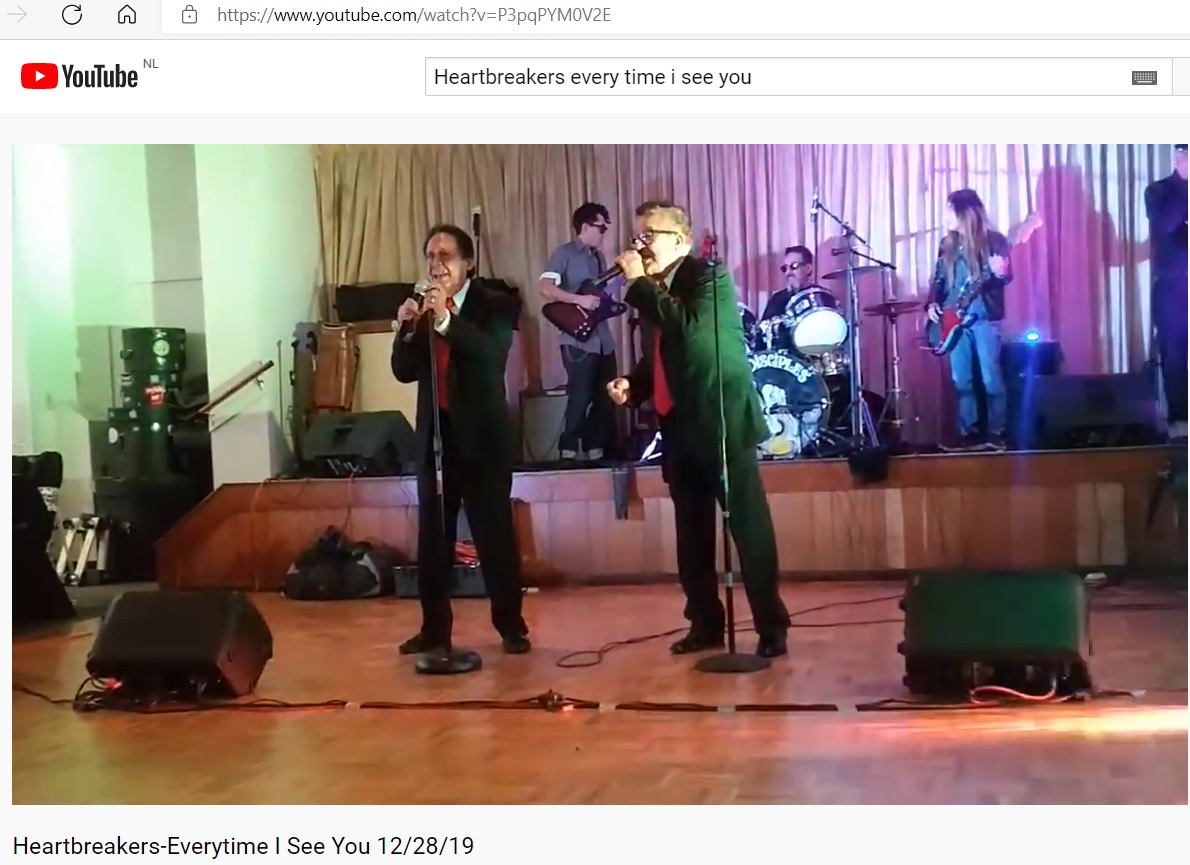
The Heartbreakers (Benny and Joe Rodriguez) singing "Everytime I see you" in 2019, as you can find them on Youtube. In 1963 they were teenagers.
Mr. Clean - Jessie Lee
A Mr. Clean (Zappa) by Mr. Clean
B Jessie Lee (Zappa)
Mr. Clean, section #1 (midi file).
Mr. Clean, section #2 (midi file).
Mr. Clean, sections (transcription).
The first example above is the chorus from "Mr. Clean" as played between 0:23 and 0:39. It's built over the chord progression C-G-C-D, a sequence of major triads.
The song in total is in G Mixolydian, though the Bb from the Dorian scale can also be heard at various points. The interlude follows the standard blues scheme.
The chord upon step V from the scheme, the D-chord, is major, common in blues, and this is also how it turns up during the chorus. The second example from above is
the end of the interlude with I-V-IV-I from the blues scheme, to be heard between 1:06 and 1:18. The first bar contains an explicit use of G7 chord. Staves 1-3 are harmony singers.
The ZFT release "Joe's XMasage" contains an alternative mix of this song. In the liner notes it gets said that they haven't been able to find out who Mr. Clean was.
In the Paul Buff archive he gets described as dark-skinned with an earring.
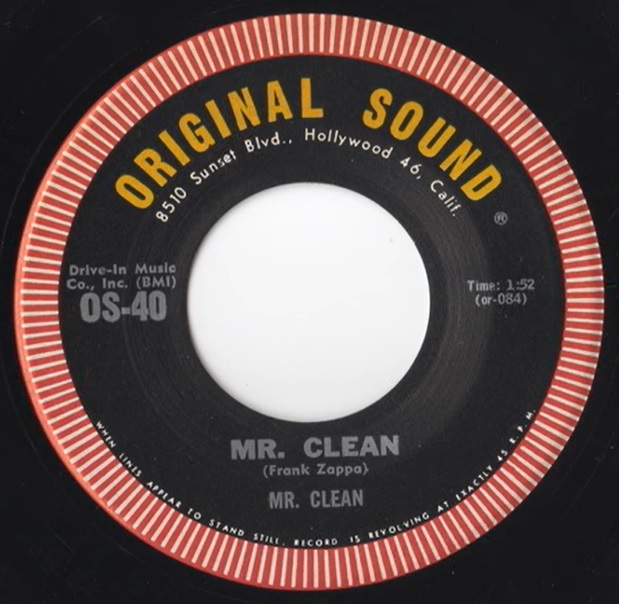
The A-side of the Mr. Clean single.
Jessie Lee, section (midi file).
Jessie Lee, section (transcription).
Jessie Lee is a short rather simple song with only one theme. The bass pattern repeats
every four bars, whereas the chords do a two bar alternation of I and VII in G Mixolydian.
The fuzz bass moves as: G (bar 2) an octave up to F (bar 3), via C back to G (bar 4), via A a second lower to F (bar 5) and via
A to the starting point F again (bar 6). In the Barry Miles biography there are quotes of both Buff and Zappa about the fuzztone bass
in this song. Buff: "Zappa loved the sound, I thought it was just ugly noise". Zappa: "He (Buff)
had the first fuzztone I ever saw. He had taken the pre-amp from a phonograph and he was
running a Sears-Roebuck bass through it. And it was a great fuzz bass. That was the first
time I ever saw anybody do a direct fuzz on a recording." The first recording with a fuzz bass is the 1963 version of "Fountain of love".
He would use the fuzz bass one more time on "Why don't you do me right" (included in the "Absolutely free" CD).
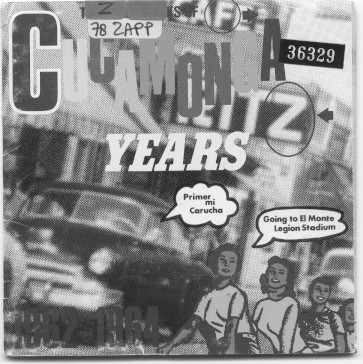 Cucamonga years CD cover.
Cucamonga years CD cover.
This CD contains most of the singles from above.
Source: MSI (Japan).
Copyright of the songs: Del-Fi Records and Original Sound,
licensed to MSI (Japan).
